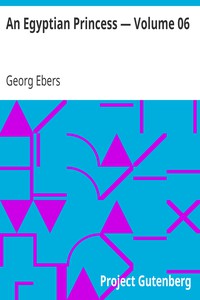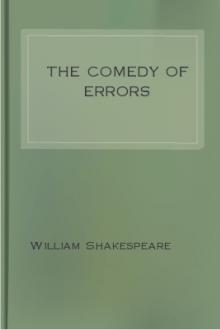An Egyptian Princess — Complete, Georg Ebers [best ereader for academics txt] 📗

- Author: Georg Ebers
Book online «An Egyptian Princess — Complete, Georg Ebers [best ereader for academics txt] 📗». Author Georg Ebers
If my space allowed I could add much more on this subject, but will permit myself only one remark in conclusion. Lovers delighted in nature then as now; the moon was their chosen confidante, and I know of no modern poem in which the mysterious charm of a summer night and the magic beauty which lies on flowers, trees and fountains in those silent hours when the world is asleep, is more exquisitely described than in the following verses, also by Sappho, at the reading of which we seem forced to breathe more slowly, “kuhl bis an’s Herz hinan.”
“Planets, that around the beauteous moon Attendant wait, cast into shade Their ineffectual lustres, soon As she, in full-orb’d majesty array’d, Her silver radiance pours Upon this world of ours.”and:—
“Thro’ orchard plots with fragrance crown’d, The clear cold fountain murm’ring flows; And forest leaves, with rustling sound, Invite to soft repose.”The foregoing remarks seemed to me due to those who consider a love such as that of Sappho and Bartja to have been impossible among the ancients. Unquestionably it was much rarer then than in these days: indeed I confess to having sketched my pair of lovers in somewhat bright colors. But may I not be allowed, at least once, to claim the poet’s freedom?
How seldom I have availed myself of this freedom will be evident from the notes included in each volume. They seemed to me necessary, partly in order to explain the names and illustrate the circumstances mentioned in the text, and partly to vindicate the writer in the eyes of the learned. I trust they may not prove discouraging to any, as the text will be found easily readable without reference to the explanations.
Jena, November 23, 1868. GEORG EBERS, DR.PREFACE TO THE FOURTH GERMAN EDITION.
Two years and a half after the appearance of the third edition of “An Egyptian Princess,” a fourth was needed. I returned long since from the journey to the Nile, for which I was preparing while correcting the proof-sheets of the third edition, and on which I can look back with special satisfaction. During my residence in Egypt, in 1872-73, a lucky accident enabled me to make many new discoveries; among them one treasure of incomparable value, the great hieratic manuscript, which bears my name. Its publication has just been completed, and it is now in the library of the Leipzig University.
The Papyrus Ebers, the second in size and the best preserved of all the ancient Egyptian manuscripts which have come into our possession, was written in the 16th century B. C., and contains on 110 pages the hermetic book upon the medicines of the ancient Egyptians, known also to the Alexandrine Greeks. The god Thoth (Hermes) is called “the guide” of physicians, and the various writings and treatises of which the work is composed are revelations from him. In this venerable scroll diagnoses are made and remedies suggested for the internal and external diseases of most portions of the human body. With the drugs prescribed are numbers, according to which they are weighed with weights and measured with hollow measures, and accompanying the prescriptions are noted the pious axioms to be repeated by the physician, while compounding and giving them to the patient. On the second line of the first page of our manuscript, it is stated that it came from Sais. A large portion of this work is devoted to the visual organs. On the twentieth line of the fifty-fifth page begins the book on the eyes, which fills eight large pages. We were formerly compelled to draw from Greek and Roman authors what we knew about the remedies used for diseases of the eye among the ancient Egyptians. The portion of the Papyrus Ebers just mentioned is now the only Egyptian source from whence we can obtain instruction concerning this important branch of ancient medicine.
All this scarcely seems to have a place in the preface of a historical romance, and yet it is worthy of mention here; for there is something almost “providential” in the fact that it was reserved for the author of “An Egyptian Princess” to bestow the gift of this manuscript upon the scientific world. Among the characters in the novel the reader will meet an oculist from Sais, who wrote a book upon the diseases of the visual organs. The fate of this valuable work exactly agrees with the course of the narrative. The papyrus scroll of the Sais oculist, which a short time ago existed only in the imagination of the author and readers of “An Egyptian Princess,” is now an established fact. When I succeeded in bringing the manuscript home, I felt like the man who had dreamed of a treasure, and when he went out to ride found it in his path.
A reply to Monsieur Jules Soury’s criticism of “An Egyptian Princess” in the Revue des deux Mondes, Vol. VII, January 1875, might appropriately be introduced into this preface, but would scarcely be possible without entering more deeply into the ever-disputed question, which will be answered elsewhere, whether the historical romance is ever justifiable. Yet I cannot refrain from informing Monsieur Soury here that “An Egyptian Princess” detained me from no other work. I wrote it in my sick-room, before entering upon my academic career, and while composing it, found not only comfort and pleasure, but an opportunity to give dead scientific material a living interest for myself and others.
Monsieur Soury says romance is the mortal enemy of history; but this sentence may have no more justice than the one with which I think myself justified in replying: Landscape painting is the mortal enemy of botany. The historical romance must be enjoyed like any other work of art. No one reads it to study history; but many, the author hopes, may be aroused by his work to make investigations of their own, for which the notes point out the way. Already several persons of excellent mental powers have been attracted to earnest





Comments (0)